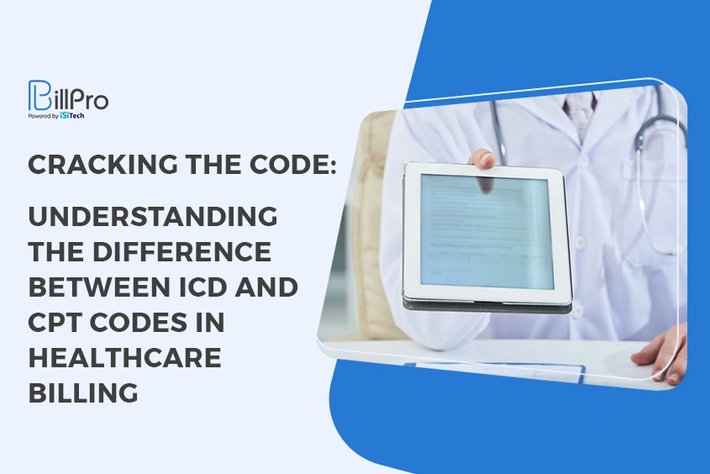Medical coding involves assigning standardized codes to medical diagnoses and procedures. Patient care must be meticulously recorded- and coded- to enable accurate billing and reimbursement.
CPT and ICD codes are at the heart of medical coding.
When a healthcare provider submits a claim to an insurance company or other payer for reimbursement, they must include the appropriate ICD code(s) to indicate the patient's diagnosis and the CPT code(s) to convey the procedures and services performed.
CPT codes are not subject to copyright restrictions and can be used by anyone.
What is ICD Coding?
Maintained by the World Health Organization (WHO), the ICD (International Classification of Disease) codes identify medical diagnoses. They enable a standardized approach to describing diseases, injuries, and other medical conditions for medical insurance entities and other stakeholders.
For example, ICD codes can indicate a patient's diagnosis of diabetes, cancer, or heart disease.
The ICD is revised regularly to keep up with medical knowledge and technology advancements. It is currently in its 11th revision–the ICD 11 officially came into effect on 1 January 2022.
In the U.S., healthcare providers and insurance companies use the ICD-10-CM (Clinical Modification) and ICD-10-PCS (Procedure Coding System) for medical coding and billing purposes. These are modified versions of the ICD 10.
One of the fundamental differences between the International Classification of Diseases 11th Revision (ICD-11) and its predecessor, ICD-10, pertains to the organization of its chapters. Unlike ICD-10, ICD-11 does not have a distinct category for mental and behavioral disorders that manifest during childhood and adolescence.
Format of ICD Coding
The ICD code format consists of alphanumeric characters representing specific diseases, injuries, and medical conditions. The fourth, fifth, and sixth characters represent the etiology, anatomic site, and severity of the condition, respectively. The seventh character indicates the episode of care, such as the initial encounter, subsequent encounter, or sequela.
For instance, the ICD-10 code for Type 2 diabetes mellitus is E11.9. The "E" indicates that this is an external cause code, while the "11" indicates that this is a code for endocrine, nutritional, and metabolic diseases. The ".9" indicates that the code is unspecified. The more digits after the decimal point, the more specified the condition is.
What is CPT Coding?
 Maintained by the American Medical Association (AMA), CPT (Current Procedural Terminology) codes are used to identify medical procedures and services performed by healthcare professionals. For example, CPT codes can be used to indicate a patient's treatment for a broken bone, physical therapy, or a routine check-up.
Maintained by the American Medical Association (AMA), CPT (Current Procedural Terminology) codes are used to identify medical procedures and services performed by healthcare professionals. For example, CPT codes can be used to indicate a patient's treatment for a broken bone, physical therapy, or a routine check-up.
There are three main categories of CPT codes.
Category I
This category encompasses codes for procedures, services, devices, and drugs, including vaccines. Category I codes are widely used and established within the medical community.
Category II
This category includes codes for performance measures and quality of care, such as patient follow-up. These codes track and evaluate the quality of care provided to patients.
Category III
This category includes codes for services and procedures that use emerging technologies. These codes are usually temporary and assigned to new or experimental procedures that are yet to be widely accepted by the medical community.
Interestingly, or counterintuitively, CPT codes are copyrighted by the AMA. Healthcare providers and organizations must obtain a license and pay a fee to use them.
Format of CPT Coding
While category I CPT codes are represented by five-digit numeric characters, category II and III are five-character codes with the fifth character being an alphabet. The codes are typically laid out in chronological order.
Category I codes range from 00100–99499 and are generally ordered based on the procedure/service type and anatomy.
Here are the six main sections of CPT Category I codes:
-
Evaluation and Management - 99202–99499
-
Anesthesia - 00100–01999
-
Surgery - 10021–69990
-
Radiology Procedures - 70010–79999
-
Pathology and Laboratory Procedures - 80047–89398
-
Medicine Services and Procedures - 90281–99607
Category II codes (0001F-9007F) typically follow Category I when billed and are arranged as follows:
-
Composite Measures - 0001F–0015F
-
Patient Management - 0500F–0584F
-
Patient History - 1000F–1505F
-
Physical Examination - 2000F–2060F
-
Diagnostic/Screening Processes or Results - 3006F–3776F
-
Therapeutic, Preventive, or Other Interventions - 4000F–4563F
-
Follow-up or Other Outcomes - 5005F–5250F
-
Patient Safety - 6005F–6150F
-
Structural Measures - 7010F–7025F
-
Nonmeasure Code Listing - 9001F–9007F
Category III codes are depicted with four numbers followed by the letter T. AMA updates the Category III codes every six months. The deletions in Category III codes and the renewed and complete set of temporary codes are published annually.
Difference Between ICD and CPT Codes
While both ICD and CPT codes are used in medical billing and the broader healthcare landscape to identify medical procedures, diagnoses, and services, there exist vital differences between the two.
So, here is the answer to what is the difference between ICD and CPT procedure code:
Purpose
ICD codes are used to identify medical diagnoses and necessities. In contrast, CPT codes are used to identify medical procedures and services and are primarily used for billing and reimbursements.
Issuing Organization
ICD codes are maintained by WHO, while CPT codes are maintained by the AMA. While ICD codes are free to use and available in the public domain, CPT codes are copyrighted by the AMA and entail a fee for use.
Format
ICD codes are alphanumeric codes that are seven characters long. CPT codes, on the other hand, are five characters long. While Category I CPT codes are numeric, Category II and III are alphanumeric, with the last character bearing an alphabet.
Categorization
ICD codes are categorized based on body systems or conditions. CPT codes are categorized based on medical treatment and procedures administered.
Accurate Coding for Medicaid Transportation Billing
.webp) The importance of getting the coding right for billing cannot be overemphasized. It is especially important in the case of Medicaid- one of the country's largest health insurance programs covering millions of low-income individuals and families.
The importance of getting the coding right for billing cannot be overemphasized. It is especially important in the case of Medicaid- one of the country's largest health insurance programs covering millions of low-income individuals and families.
More so for Medicaid transportation billing, which involves submitting claims for reimbursement to Medicaid for the transportation services provided to eligible beneficiaries.
While CPT codes indicate the specific transportation services provided, such as non-emergency or specialized medical transportation, ICD codes indicate the medical condition or diagnosis of the patient for whom transportation services were provided. In today’s day and age of digital prominence, electronic coding is the way to go for all kinds of medical billing.
To that end, BillPro is a holistic Medicaid transportation billing software- particularly suitable for New York Medicaid transportation firms, including those that operate outside the state. The BillPro portal requires no downloads or installation and is inherently cost-efficient and user-friendly.
BillPro’s features include:
-
Claim corrections
-
Automatic data imports
-
Batch updates
-
Provider ID correction
-
Auto-remittance resolution
-
Cross-platform compatibility
-
Custom reporting
Get started with BillPro today and streamline your Medicaid transportation billing. Hundreds of companies have entrusted BillPro to drive away their billing hassles. Why shouldn’t you take advantage of our free trial and see how it can help you?

 5/5 (2 votes)
5/5 (2 votes)
 2543 views
2543 views



